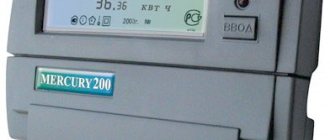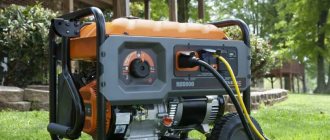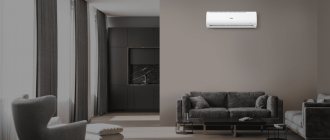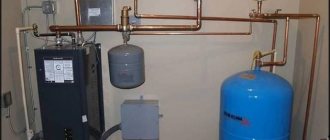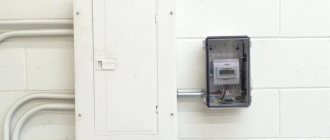The purpose of an RCD has already been discussed several times, and its installation in a modern household electrical network is definitely the most important protection for a person from electric shock. But how to choose an RCD? Based on what parameters? How to calculate a device for a particular protected consumer? Let's try to figure it all out.
To make the right choice of RCD, you need to understand its purpose, main characteristics and parameters. When you buy a device, pay attention to its case, all the important information is indicated there. So that these numbers and letters tell you something, we will analyze each of them separately.
Purpose
The most important thing to understand is that a circuit breaker protects the electrical network from overcurrents, and an RCD provides human protection. If, as a result of an insulation breakdown, potential appears on the body of an electrical appliance, touching it is likely to result in an electric shock. To prevent this from happening, immediately when a current leak occurs, the protective shutdown device will react and turn off the damaged section of the circuit.
It is important to know! RCDs do not protect against overloads and short circuits, so circuit breakers must be connected in series with them in the circuit.
Which RCD to choose
Recommendations for selection:
1. If the circuit contains a 16 A circuit breaker, the RCD is selected one step higher - 25 A, for a 25 A circuit breaker - 50 A, etc. In this case, even if there is an overload in the network, the RCD will operate normally. Otherwise, excessive loads may affect the reliability of the device and shorten its service life.
Trademark
Speaking about the brand, we will essentially analyze the price-quality ratio. The fact is that there is an unspoken classification of all RCD manufacturers according to their territorial location - European models, Asian and Russian.
One way to spot a fake video:
Each of their products has its own characteristic features:
- Both a fire-fighting RCD and a device that protects people from electric shock produced in Europe will cost an order of magnitude more than models from Russia and China. But this price guarantees quality and reliability. It will not be amiss to know that some European companies, in addition to the main high-quality assortment, produce RCDs for the markets of other countries with the same reliability, but with reduced technical characteristics.
- Domestic manufacturers offer RCDs at a lower price than their counterparts from Europe, however, they meet all regulatory requirements of Russian standards. So far, Russian manufacturers' sales network is not so strong, and the devices themselves are not able to compete with Asians in price or with Europe in terms of quality.
- RCDs from Asian manufacturers are in greatest demand in the world. Some manufacturers from Asia enter into contracts with suppliers of products to the Russian market and in this case produce devices under the Russian brand.
Before choosing an RCD brand, decide what means you have for installing automatic protective equipment in an apartment or private house. Most preferred companies:
- Swiss "ABB";
- French Legrand and Schneider Electric;
- German "Siemens" and "Moeller".
Among domestic manufacturers, the most widely used products are:
- Kursky, average price and quality, the company gives a two-year guarantee for the RCDs produced, which indicates the reliability of the products;
- Moscow (“IEC”), products do not always receive positive reviews, however, the demand for it is high due to its low cost;
- Ulyanovsk, it is part of the group, which affects the quality of the products and, accordingly, the price;
- relatively young St. Petersburg, on the Russian market it represents the world-famous company “Schneider Electric”.
As for Chinese manufacturers, the RCDs they produce are a direct competitor to Russian devices. Price and quality are approximately at the same level, while the warranty period for Chinese goods is five years.
Main settings
After the trademark, the main ratings and performance characteristics of the RCD are indicated on the body.
- Model name and series. Please note that here you will not always see the letters RCD; some manufacturers designate this device as a VDT (residual current switch).
- The value of the rated voltage and frequency. In the Russian power system, the operating frequency is 50 Hz. As for voltage, for a single-phase network in an apartment it is 220-230 V. For a private house, a three-phase network is sometimes needed and the operating voltage will be 380 V.
Characteristics of the RCD in the video:
- The rated operating current is the maximum value that the RCD is capable of switching.
- Rated differential current. This is the value at which the device is triggered.
- The temperature limits of the RCD operation are also indicated here (minimum - 25 degrees, maximum + 40).
- Another current value is the rated conditional short-circuit current. This is the maximum short circuit current that the device will withstand and not turn off, but provided that a suitable circuit breaker is installed in series with it.
- Nominal response time. This is the time period from the moment when a current leak suddenly occurs until it must be extinguished by all poles of the RCD. The maximum permissible value is 0.03 s.
- The RCD diagram must be drawn on the housing.
Leakage current shape
According to this parameter, all residual current devices are classified into three types:
- "A". Such a device trips when instantaneously occurring or gradually increasing current leaks have a sinusoidal variable or pulsating constant shape. This is the most common type of RCD. Due to the fact that it controls both alternating and direct current, it is more expensive.
- "AS". Also a common and more affordable device. It only works to generate alternating sinusoidal current leakage.
- "IN". This device is mainly used to protect industrial premises. In addition to the alternating sinusoidal RCD, it responds to the rectified and pulsating form of direct current leakage.
A completely logical question arises: in household networks, alternating current of a sinusoidal shape flows; can it be sufficient to install “AC” type devices everywhere? But if you take a closer look at the characteristics of modern household appliances, most of them have power supplies with electronic semiconductor components, reaching which the sine wave is converted into pulsed half-cycles. And if the leak is not of a sinusoidal nature, then the AC type RCD will not detect it and will not turn off.
That is why in the passports for many household appliances the manufacturer indicates through which RCD the connection must be made.
Tips for choosing an RCD on video:
RCD selection parameters
Trip type
RCDs installed in apartments have two types of tripping: A and AC.
AC type devices are triggered by an alternating sinusoidal leakage current that appears suddenly or gradually increases.
Type A devices respond to alternating sinusoidal and constant pulsating leakage currents that arise suddenly or gradually increase (recommended for installation on lines serving household electrical appliances, where rectifiers and switching power supplies are installed: computers, televisions and other equipment equipped with electronics).
Selectivity
A selective RCD (S - with a longer shutter speed, G - with a shorter shutter speed) is installed at the input in front of other devices serving different groups in an apartment or cottage.
It detects a leak, but only triggers after a certain period of time (delay 0.2-0.5 seconds). Thanks to this, groups where there was no leakage are not de-energized.
Number of poles
Depending on the voltage in the network, the number of poles in the device used depends: for a 220 V network - two-pole, for a 380 V network - four-pole.
Rated protection current
The parameter determines how much current the device can carry during continuous operation. The indicator must be equal to or one step higher than that of the circuit breaker protecting the same section of the circuit.
Rated residual current
This indicator determines the leakage current at which the switch will trip. An RCD with a rating of 30 mA is considered universal; it will provide protection against electric shock and fire, and can be used in lines with a fairly large load without false alarms.
Switches with an indicator of less than 30 mA are not always able to ensure fire safety; under significant loads they often operate erroneously.
Nominal trip time
An indicator that determines the time interval between the moment a leak appears and the moment the switch operates. Standards define the maximum permissible response time to 0.3 seconds; high-quality devices operate in 0.02-0.03 seconds.
Operating temperature
Most switches are designed to operate in a temperature range from -5 °C to +40 °C; if necessary, you can purchase a device capable of responding to temperatures down to -25 °C.
Operating principle
There are electronic and electromechanical RCDs.
The second is more expensive, but does not depend on the power supply. It will work as soon as a current leak occurs in the circuit.
An electronic device in its operation depends on an amplifier built into the electrical circuit. And in order for this amplifier to always be in working condition, it requires an external power source. In this regard, the reliability of operation is reduced.
When choosing an RCD for this parameter, we recommend giving preference to electromechanical devices.
Criteria for correct selection
Rated current
The first thing you need to pay attention to is what current the device is designed for. To choose the right RCD for current, you must first decide for what purpose the product will be installed. If you want to protect a separate network element, for example, a washing machine, an electric heated floor system or a water heater (boiler), the value can be no higher than 16 A. For all electrical wiring in the apartment, you need to install the unit at least 32 A. To select the correct value, you first need to calculate the load from all connected electrical appliances and, based on the resulting amount, select the most suitable RCD model. Manufacturers usually indicate the rated current load on the case of modern equipment, so calculations should not be difficult.
Differential current
We have considered all the existing values, which range from 10 to 500 mA, now we will figure out which RCD is better to choose based on amperage in certain situations. Protection of a person from electric shock is provided by settings from 6 to 100 mA. At the same time, leaks above 30 mA will be felt by the human body. That is why it is better to choose a 10 mA model for children’s rooms and bathrooms, and 30 mA to protect sockets and lamps.
It should also be noted that each electrical appliance has a natural leakage current, which is indicated in the attached technical data sheet. When choosing an RCD based on leakage current, be sure to take into account the following rule: the sum of natural leakages should not exceed the rated value of the protective device by more than 30% (1/3). Otherwise, false positives will occur, which will cause a lot of trouble.
Product type
So, in simple words we explain the purpose of each type of RCD:
- AC - mainly used to protect electrical appliances at home when using both single-phase and three-phase networks. Such a product cannot protect household appliances with pulsating current, for example, a washing machine.
- A - is used specifically for separate protection of washing machines in apartments and private houses.
- B - mainly used in production, so there is no point in choosing this type for home.
- S - as we have already said, shutdown does not occur immediately when a leak is detected, but after a certain time setting. As a rule, it is used to prevent fire and is connected at the input panel, servicing all electrical wiring (therefore, the setting for the leakage current is selected at least 100 mA).
- G – mainly connected to a separate electrical device for control and timely fire protection. Unlike the “S” type, it has a shorter exposure time.
Design
There is nothing special to talk about here; electronic ones have a more complex operating principle and function only if there is a power source (external or mains power). Electromechanical ones are more reliable and durable, so it is better to choose an electromechanical RCD for an apartment or house, and the cost will be much lower.
Manufacturer
Well, the last, no less important criterion for choosing an RCD is based on the manufacturer. Today, the best companies in the production of these products are the following companies:
- Legrand;
- ABB;
- AEG;
- Schneider electric;
- Siemens;
- DEKraft.
Among budget models, the highest quality is from the companies Austro-UZO and DEK.
We recommend giving preference to more expensive products, but if the budget does not allow, domestic manufacturers will also cope well with protection. In any case, before purchasing, we advise you to visit electrical forums and read customer reviews about the chosen model! This way you will probably find out all the advantages and disadvantages of the product and determine exactly which RCD is better to choose.
Selectivity
According to the selectivity of operation, residual current devices are of two types - “G” and “S”.
These RCDs are triggered after a certain period of time, called dwell time. They are used when several devices are connected in series. To protect outgoing consumer branches, devices are installed without a time delay, and at the input there are RCDs of type “G” and “S”. If a current leak occurs and the outgoing RCD does not respond, then after a certain time the device at the input should turn off.
For RCDs of type “S” the shutter speed is set in the range from 0.15 to 0.5 s, for type “G” - from 0.06 to 0.08 s.
Two-level fire protection
For a wooden private house, guaranteeing fire safety is especially important. Therefore, in this situation, it is necessary to select an RCD, planning a two-level differential protection system. Its main purpose is that the protective function is divided:
- fire protection RCD ensures operation in case of large current leaks that contribute to fire;
- ordinary devices will prevent electric shock to a person with small leakage values.
Since the fire protection RCD has a high leakage current rating, it will not provide human protection on its own. Therefore, it is always installed together with an RCD, which has less leakage current.
Regardless of the value of the rated operating current and how many poles a fire protection RCD has, the leakage current parameter of such a device is 100 mA and 300 mA, otherwise it is no different from an ordinary one.
The connection diagram is carried out sequentially, we install a fire protection RCD closer to the power source (at the input), and universal ones on the outgoing branches of the protected wiring.
Visually about the fire protection RCD in the video:
Using an example, it looks something like this: we select the input RCD with parameters 63 A (nominal operating current) and 300 mA (leakage current), the remaining devices, respectively, are 40 A and 30 mA for the socket group, 25 A and 10 mA for the bathroom, 16 A and 10 mA for the lighting group.
The use of fire-fighting devices is also advisable in an apartment. Often the lighting group is left unprotected from leakage currents. With minimal probability, but high current leaks can occur in this branch, and if such an RCD is installed at the input, it will be a kind of safety net.
Performing calculations
Let's try, using an example, to calculate which RCD still needs to be chosen for a particular protected branch of electrical home wiring.
In practice, it is not always possible to accurately calculate the total leakage current. Therefore, it is approximately determined by the following method: for 1 A of consumed load, take 0.4 mA of current leakage. You should also make a calculation based on the length of the phase wire - 10 μA is taken per 1 m.
Let’s say you need to choose the right RCD according to the power of the electric stove (3 kW). First, we calculate its load: 3000 W / 220 V = 13.64 A. Leakage current for the stove: 13.64 A x 0.4 mA = 5.46 mA. We perform the same calculation for a laid conductor, for example, 10 m: 10 µA x 10 m = 100 µA = 0.1 mA. In total, the leakage current is: 5.46 mA + 0.1 mA = 5.56 mA.
The resulting value of the sum of current leakage should not exceed 33% of the differential rated current of the RCD. And then the calculation from school mathematics lessons, we make an elementary proportion and get: 5.56 mA x 100% / 33% = 16.85 mA.
There is a special table of standard values of rated leakage currents, based on it, a 25 mA device is suitable for an electric stove.
You now know how to choose an RCD for an apartment or house, and you can determine the total calculated leakage current yourself. If you have even the slightest doubt about your knowledge and abilities, invite a professional electrician to do this work. Do not forget that the residual current device is a guarantee of your safety.
How to choose the right one
To choose an RCD for an apartment, cottage or country house, you must first decide on the level of security that you plan to achieve.
The first thing to consider is the type of wiring. If the wiring is old, then installing a current differential switch is pointless: it will almost certainly contain leakage currents. If you select and install an RCD with a limit of 30 mA, it will trip too often.
If you install a device with a higher shutdown threshold, then it will have no practical meaning.
In addition, many brands of VDTs are not designed to work with aluminum wiring, which was the standard for apartments in houses built in the USSR.
